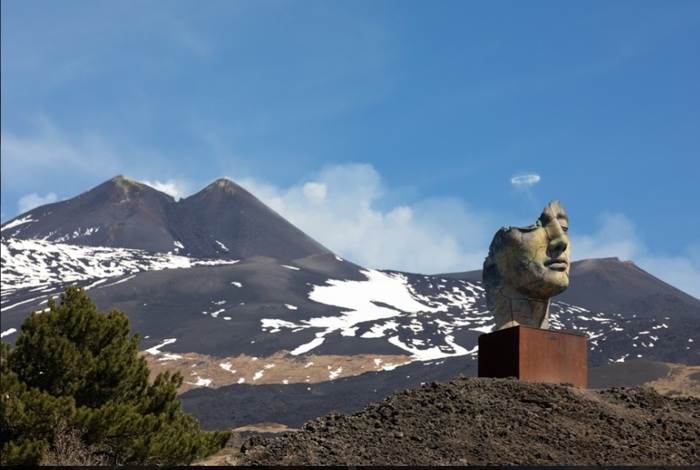Everything changed when the north pole went south
Human action is rarely linked to beneficial effects in nature.
However, in Tenerife (Canary Islands), the irrigators of Lomo Morín have managed to sculpt an enclave where, using water as a chisel, they have transformed a problem into an opportunity and generated a natural laboratory that accelerates geological processes of thousands of years to reduce them to only four decades.
A study led by the director of the Geological Mining Institute of Spain (IGME), Ana María Alonso Zarza, and published in
Anthropocene
, has revealed how the actions to take advantage of the water in the area for irrigation have created an extraordinary natural treatment plant, forming impressive formations rocky and generated a sink of CO₂.
Water is a precious commodity.
It is the basis of life.
The farmers of the Lomo Morín skirt had it close by and channeled it to use it in their crops.
However, the first attempts to conduct the water through pipes failed due to the calcification of the pipes and because the water arrived with excess ions that made it unfit.
Scheme of the irrigation system of Lomo Morín and its effects.Ana María Alonso Zarza
Instead of fighting against nature with great works, they decided to take advantage of it, to ally themselves with it.
They channeled the water that reaches underground galleries after filtering through the volcanic rocks that make up the island and rich in carbon dioxide (CO₂).
By means of a channel that circulates on the surface, they brought the water to a slope with a high slope and thus the Lomo Morín waterfall was formed.
In this way, as detailed in the research, of which the geologists Ramón Casillas, from the University of La Laguna, and Álvaro Rodríguez-Berriguete, from the Complutense of Madrid are part, the irrigators achieved the mechanical degassing of the CO₂ and, with it , calcite precipitation on the slope.
In just 40 years, the action of the irrigators achieved the effect that the Earth, alone, would have taken thousands of years to produce
But the modification of the hydrogeological system has not only generated an extraordinary natural treatment plant.
The intervention has generated geological formations (tuffs) of cubic meters, thanks to the precipitation of calcite, which in other places only reaches a few millimeters naturally.
In just 40 years they achieved the effect that the Earth, alone, would have taken thousands of years to produce.
Lomo Morín waterfall and, on the left, geological formations generated by Ana María Alonso Zarza
The Lomo Morín tuff formations have created a new landscape that caught the attention of María Isabel Sánchez Bonilla, sculptor and professor of Fine Arts in La Laguna.
Calcium carbonate envelops the plants in the environment closest to the waterfall, shaping unique formations of great beauty.
"It is a natural 3D printer," explained the artist when she drew the researchers' attention to the phenomenon that emerged in Lomo Morín.
The use of water, according to the research, "has generated changes in the conditions that have increased the geological and bioecological diversity of the island"
Research has discovered the complex benefits of human intervention on the landscape.
Alonso Zarza sums it up: "Lomo Morín is a unique example of how the interaction of volcanic rocks, water, vegetation, CO₂ and human activity have generated a spectacular landscape of multiple waterfalls that are petrified in a few years" .
This sculpture of the irrigators on the landscape, according to the study, "has generated changes in the conditions that have increased the geological and bioecological diversity of the island."
Because not only a natural water treatment plant, a geological workshop and a new landscape have been created.
Lomo Morín is also a CO₂ sink "comparable to the global carbon cycle, which mainly involves marine limestone," according to the research.
Rocks formed by the precipitation of calcite AMAZ
The researcher who directs the IGME considers that the study demonstrates the applications of the Canarian system in places where high concentrations of carbon dioxide occur due to industrial or natural processes.
In this sense, it stands out that countries like Iceland already apply similar methods to sequester emissions (CO₂).
The same study recalls how dismantled dams or abandoned steelworks have generated outstanding geological processes.
And not only in recent works.
Roman aqueducts in Turkey and France have generated remarkable calcite formations in a much shorter time than natural.
This research allows not only to study a geological model on a human time scale against natural systems that take thousands of years, but also opens the door to actions to recover enclaves similar to Lomo Morín, in decline throughout Europe since the mid-Holocene. due to climate change, increased erosion and turbidity rates of streams, alterations in nutrient content and CO₂ fluxes, water pollution, variations in insolation and temperature, and deforestation, which modify the balance of calcium carbonate and the productivity of plants.
You can follow MATERIA on
,
and
, or sign up here to receive
our weekly newsletter
.






/cloudfront-eu-central-1.images.arcpublishing.com/prisa/JEEPQTR4AVGKDDJ24B4CKAATNY.jpg)


